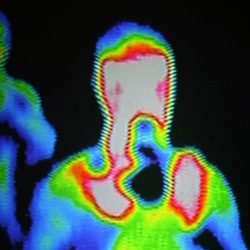 |
| Thermal surveillance cameras have numerous security benefits |
All network cameras have a basic physical limitation: they need light to work. Phil Doyle, Regional Director, Northern Europe at Axis Communications examines the key benefits of thermal imaging cameras in surveillance.
Some network cameras have night and day vision capability that allows them to operate in very poor lighting conditions, down to fractions of a lux. And of course, if natural light is not available it can be substituted by electrical light which is either visible to the human eye or infrared. But in some instances, these solutions have serious drawbacks. For instance, they can be expensive, energy consuming, and illumination creates shadows where an intruder can hide.
The first true thermal network camera is a perfect complement to any professional IP-surveillance system. It can be seamlessly combined with existing equipment and it is possible to secure an area or a perimeter that lies in complete darkness.
The heat is on : thermal imaging goes mainstream
Although thermal imaging is nothing new, costs have usually been prohibitive, making practical applications outside the military rare. It was only recently that this has started to change as new sensors, new materials, and other improvements have been driving the volumes and making prices more reasonable. Thermal cameras can now be found in various lines of business such as the aircraft industry, shipping industry, and security and surveillance. The technology is also used in public services like fire fighting and law enforcement. Lately, it has even appeared in consumer products, albeit often expensive ones like luxury cars.
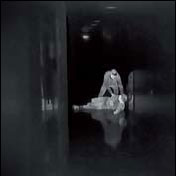 | 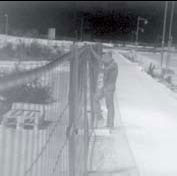 |
| Unlike conventional cameras, thermal cameras can detect people and objects in a wider range of environmental conditions | |
How thermal cameras work
Like any other camera, a thermal or thermographic camera collects electromagnetic radiation which is formed into an image. But while a conventional camera works in the range of visible light, i.e. with wave- lengths between approximately 400 and 700 nanometres (0.4-0.7 mm), a thermal camera is designed to detect radiation with greater wavelengths, up to around 14,000 nanometres (14 mm). Radiation in this part of the electromagnetic spectrum is referred to as infrared, or commonly IR, which in turn can be divided into several sub-groups.
Near-infrared light has a wavelength of about 0.7-1.5 µm, which is just beyond what the human eye can see. Camera sensors, on the other hand, can be built to detect and make use of this type of radiation. A so-called day-and-night camera uses an IR-cut filter during daytime to filter out IR-light so it will not distort the colours of images as perceived by the human eye. When the camera is in night mode, the IR-cut filter is removed. Since the human eye is unable to see infrared light, the camera displays the image in black and white. Near- infrared light also requires some kind of light source - either natural, such as moonlight, or man-made, such as street lights or a dedicated IR-lamp.
Moving further away from visible light, the rest of the IR-spectrum is usually divided into the following categories:
- Short-Wave Infrared (SWIR), approx. 1 - 3 µm
- Mid-Wave Infrared (MWIR), approx. 3 - 5 µm
- Long-Wave Infrared (LWIR), approx. 8 - 12 µm
- Very Long-Wave Infrared (VLWIR), approx. 12 - 25 µm
- Far-Wave Infrared (FWIR), approx. 25 µm - 1 000 µm or 1 mm
Note that there is a gap between 5 µm (MWIR) and 8 µm (LWIR). This part of the waveband is virtually unusable for thermal imaging purposes because of the high spectral absorption of the atmosphere in this range.
Microwaves have a wavelength exceeding 1 mm. At the far end of the spectrum are radio waves, with a wavelength of 1 meter and more. In the other end of the spectrum, wavelengths shorter than those of visible light are successively referred to as ultraviolet, x-rays, and gamma rays.
 |
| Conventional cameras work in the range of visible light, i.e. with wavelengths between approximately 0.4-0.7 mm. Thermal cameras, on the other hand, are designed to detect radiation in the much broader infrared spectrum, up to around 14 mm (the distances in the spectrum above are not according to scale) |
What makes thermal imaging work?
Images, as they are perceived by the human eye, can be described as light reflected by different objects. No light means no reflection and thus the eye is "blind" under such circumstances. Thermal images on the other hand, are not dependent on visible light. Instead, images are created by operating in the infrared spectrum. It works perfectly well even in total darkness since the ambient light level does not matter.
What makes this possible is the fact that all objects - organic or inorganic - emit a certain amount of infrared radiation as a function of their temperature. This is true for all objects that have a temperature that is above absolute zero, i.e. 0 degrees Kelvin (-273° C or -459° F). That means that even very cold objects, such as ice or an outdoor steel post in winter, emit thermal radiation.
The ability to emit absorbed energy is termed emissivity. All materials have more or less emissivity (e). Their respective values range from 0 to 1, depending on their different properties. The latter value only applies for a theoretical object called a Black-body. In general it could be said that the duller and blacker a material is, the closer its emissivity is to 1. Conversely, a more reflective material has a lower e value. For example, highly polished silver and brass have an emissivity of about 0.02 and 0.03, respectively. Iron has an emissivity of 0.14 - 0.035 if polished, but 0.61 if it has rusted red. Regular glass, which effectively blocks thermal radiation, has an emissivity of 0.92.
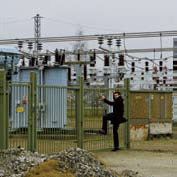 | 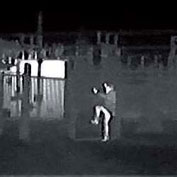 |
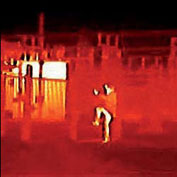 | All objects emit thermal radiation which can be detected with a thermal network camera. Images are generally produced in black and white but can be artificially coloured to make it easier to distinguish different shades |
An object's thermal radiation is also dependent on its temperature - the hotter it is the more thermal radiation it emits. Humans cannot see this, but we can sense it, for example, when we approach a camp fire or enter a sauna. The greater the temperature difference in a scene, the clearer will the thermal images will be.
Furthermore, some materials will have a different emissivity in the mid-wave infrared spectrum than in the long-wave span. For imaging purposes, these differences in emissivity are, for the most part, of secondary importance since the camera's sensitivity can be defined as its capability to distinguish between temperature differentials.
Thermal images are sometimes associated with bright, intense colours - which may seem a bit odd considering that the camera works outside the spectrum of visible light. This is because the colours are created digitally (so-called pseudo-colours). Each colour or nuance represents a different temperature, usually white and red for higher temperatures, over green, blue and violet for colder ones. The reason is foremost practical since the human eye is better at distinguishing different shades of colour than different shades of grey.
Detectors used for thermal imaging can be broadly divided into two types: cooled thermal imagers that typically operate in the mid-wave infrared (MWIR) band and uncooled thermal imagers that operate in the long-wave infrared (LWIR) range. Both are discussed in further detail below.
As cold as it gets - cooled detectors
"Thermal cameras are superior to conventional cameras when it comes to detection under a wide range of difficult weather conditions" |
Cooled infrared detectors are usually contained in a vacuum-sealed case and cooled to temperatures as low as 60 to 100° K (circa -210° to -170° C or -346° to -274° F), depending on the type and level of performance desired. These extremely low temperatures are accomplished with so-called cryogenic coolers. Cooling is needed to reduce thermally induced noise - at higher temperatures the sensors risk being flooded or "blinded" by their own thermal radiation. The equipment not only makes the detectors relatively bulky and expensive, but also rather energy-consuming.
Although this technology is both expensive and demanding in maintenance, it has benefits. These detectors work in the mid-wave spectral band, which provides better spatial resolution because the wavelengths are much shorter and provide higher thermal contrast than in the long-wave band. Hence, cooled detectors can distinguish smaller temperature differences and produce crisp, high resolution images.
Another advantage is that greater sensitivity also allows the use of higher F-number lenses. Consequently, cooled detectors are a better choice for long range detection, i.e. 5 km - 16 km (3 - 10 mi).
Uncooled thermal cameras
The sensor in an uncooled thermal camera is not dependent on cryogenic cooling. In this case, the sensor is stabilised at or close to the ambient temperature using less complicated temperature control elements. Sensors of this kind operate in the long-wave infrared band.
Uncooled thermal image sensors are smaller and built with fewer moving parts. Not only does this make them less expensive than their cooled counterparts but also allows for much longer service intervals. Whereas the cooled cameras typically need a rebuild for the cryocooler every 8,000 to 10,000 hours, an uncooled camera can run continuously for years.
Come rain or shine - performance advantages of thermal cameras
Thermal cameras do not only perform well in total darkness, they also perform well under difficult climatic circumstances such as haze, dust, rain, snow and smoke. All the same, there are physical limitations to the performance of thermal cameras.
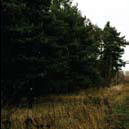 | 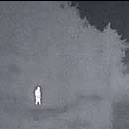 |
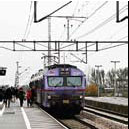 | 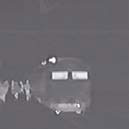 |
| Thermal network cameras are an excellent complement to regular surveillance cameras, particularly under difficult lighting situations | |
Water droplets or small dust particles in the air will naturally hinder the transmittance of thermal radiation from a single object, making it harder to detect from a great distance. Consequently, haze, snow and rain will hamper camera performance. Water limits thermal radiation and the moisture in the air evens out temperature differences between different objects in the picture. Therefore, a thermal camera will produce better and clearer images during winter time with clear skies and good weather conditions than under comparable atmospheric conditions during summer when humidity is usually higher.
Even with these limitations considered, thermal cameras are superior to conventional cameras when it comes to detection under a wide range of difficult weather conditions.
Challenges of integrating thermal cameras into conventional video surveillance
The integration of thermal cameras into the conventional video surveillance market is not free from challenges - technical, legal and others.
Regardless of these restrictions, resolutions are generally much lower for thermal cameras than for conventional network cameras. This is primarily due to the more expensive sensor technology involved in thermal imaging. However, lower frame rate is less of a problem in most surveillance applications since thermal cameras are first and foremost used for detection and not for identification.
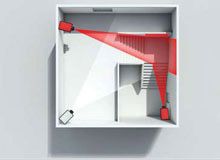 |
| No lurking in the shadows! Thermal network cameras can also be used indoors to improve building security and emergency management |
Blocked by glass: lack of standard optics for thermal cameras
More troublesome, at least from an economic point of view, is that there are no standard optics for thermal cameras. Any adaptation of focal length or a special required field of view must be done at the factory. The reason why regular optics and lenses, such as a standard CS-mount or C-mount, cannot be used is that ordinary glass efficiently blocks thermal radiation. Manufacturers therefore have to rely on other materials. Presently, Germanium is most used for thermal camera optics. This very expensive metalloid, chemically similar to tin and silicon, blocks visible light while letting thermal radiation through.
Naturally, the same requirements apply for housings, making it impossible to use standard camera housings for outdoor installations. Like lenses, housings must thus be specially adapted for thermal cameras.
New ground for thermal cameras
Although the investment costs are high, thermal cameras are not unknown within security and surveillance. On the contrary, they are primarily used in high security buildings and areas, such as, nuclear power plants, prisons, airports, pipelines, and sensitive railway sections.
"Thermal cameras can be an excellent complement in many situations where conventional surveillance cameras are inadequate or insufficient" |
So far, however, incorporating thermal cameras into a conventional video surveillance system has not been a straightforward operation. With the development of thermal network cameras, compatibility will of course, be far less of an issue. New devices will more easily integrate with, for example, existing video management systems.
Among other benefits that IP-surveillance brings are Power over Ethernet (PoE), distributed intelligent video, standardized video compression techniques, and audio support.
PoE is a technology for safe and simultaneous transfer of electrical power and data in Ethernet networks, thus eliminating the need for power cables and reducing installation costs. Intelligent video is a comprehensive term for any solution where the video surveillance system automatically performs an analysis of the captured video, such as motion detection, audio detection, and virtual fences, or sets off an alarm when cameras are vandalized or tampered with. With thermal network cameras, this analysis can be distributed out to the cameras, thus leading to improved efficiency and scalability.
Excellent complement to conventional video surveillance systems
With thermal imaging becoming relatively cheaper and an integral part of IP-surveillance systems, a whole range of uses becomes both possible and economically viable. Thermal cameras can be an excellent complement in many situations where conventional surveillance cameras are inadequate or insufficient.
They are, of course, unparalleled in a situation of total darkness. They can also be an option in areas that are very difficult to illuminate effectively, for example a sea front, a harbour, or any other vast expanse of open water. Similarly, artificial light not only runs the risk of revealing where the cameras are placed, enabling parties to avoid or vandalize them, but can also create projected shadows in which an intruder can avoid detection.
Furthermore, spotlights can blind as well as illuminate. So surveillance cameras that do not rely on light can be the preferred solution in many different traffic situations, whether it is in railway tunnels, on air strips, or on regular streets. Thermal cameras, on the other hand, cannot be blinded by bright lights or laser beams.
All in all, thermal network cameras perfectly complement and complete a network video system, making sure that objects, people, and incidents are detected 24 hours a day, seven days a week.
 | Phil Doyle, Regional Director, Northern Europe Axis Communications |





















